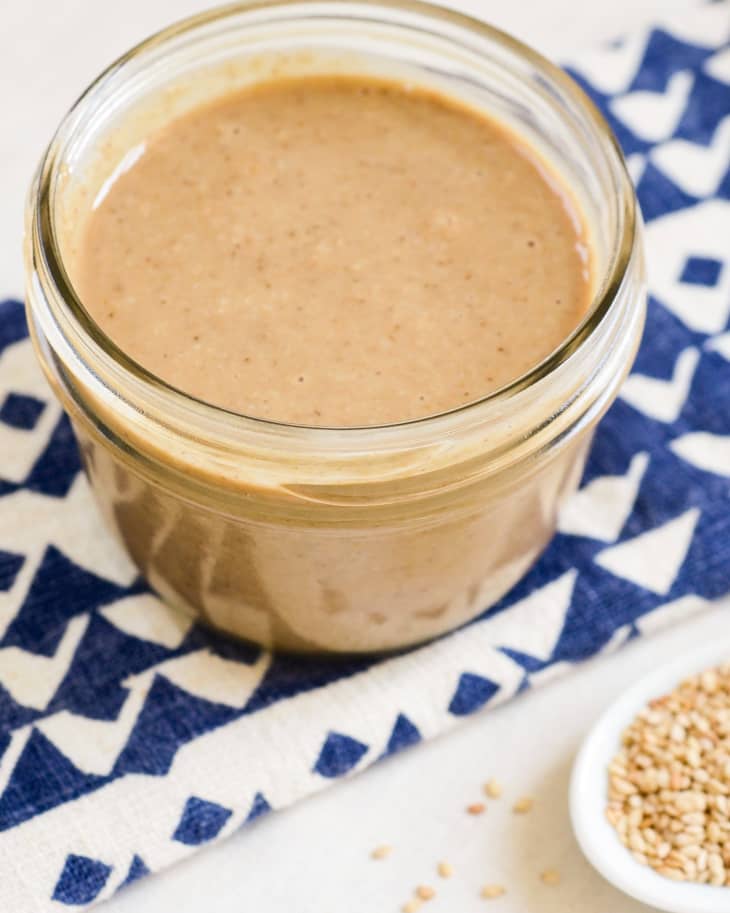How To Make Tahini

Tahini, or sesame seed paste, is a staple of Middle Eastern and Mediterranean cooking. It’s perhaps most notable for its essential role in making hummus, although its uses go far beyond that iconic dip.
But tahini can get pricey at the grocery store, and it’s sometimes bitter or rancid after its long wait on the shelf. The good news is you can make this pantry staple at home for a fraction of the cost — and chances are it will taste better, too! You only need two ingredients: sesame seeds and oil.
The Sesame Seeds
You can make homemade tahini from any sesame seeds: unhulled or natural, hulled, raw, sprouted, or toasted. Each variety lends a different flavor, color, and texture to the tahini.
Commercial tahini is typically made from white hulled sesame seeds, or seeds where the hull has been removed. This gives the tahini a lighter color and smoother texture. Tahini made from unhulled or natural sesame seeds is not quite as smooth, but it has a richer (albeit sometimes more bitter) flavor and potentially more nutrients.
Using raw, sprouted, or toasted sesame seeds is up to personal preference. Toasting the sesame seeds enhances the nutty flavor and can also reduce bitterness.
Tahini can even be made from black sesame seeds, creating an Asian-style black sesame paste.
→ Shopping Tip: Look for sesame seeds in bulk bins or at Asian and Middle Eastern markets for the best deals.
The Oil
Like other nut and seed butters, tahini can be made without any added oils. However, it takes longer to grind and the result is not as creamy as it is when using oil. Start with a couple of tablespoons of oil and increase as desired for a thinner consistency.
For the best flavor use a mild olive oil, a neutral oil such as grapeseed oil, and/or a small amount of sesame oil.
The Method
Many tahini recipes call for grinding the sesame seeds and oil together all at once. I have found that grinding the seeds before adding the oil produces a smoother result.
6 Ways to Use Tahini
How To Make Tahini
Makes about 1 cup
Nutritional Info
Ingredients
- 1 cup
sesame seeds
- 2 tablespoons
or more mild olive oil, a neutral oil such as grapeseed oil, and/or a small amount of sesame oil
Salt (optional)
Equipment
Measuring cups and spoons
Skillet or rimmed baking sheet
Wooden spoon
Food processor (or mortar and pestle, or blender)
Spatula
Storage container
Instructions
Toast raw sesame seeds (optional): Toasting raw sesame seeds gives the tahini a nuttier flavor. On the stovetop, place the sesame seeds in a dry skillet over medium heat, stirring them frequently with a wooden spoon. Toast the seeds until they are lightly colored (not brown) and fragrant, about 5 minutes. Transfer the toasted sesame seeds to a large plate or tray and let them cool completely. Alternatively, toast the seeds in the oven: Preheat the oven to 350°F. Spread the sesame seeds on a rimmed baking sheet. Toast the seeds, stirring once or twice, until they are lightly colored (not brown) and fragrant, about 5 minutes. Transfer the toasted sesame seeds to a large plate or tray and let them cool completely.
Place the sesame seeds in a food processor: Place the sesame seeds in a food processor fitted with the S-blade. (Alternatively, you can use a mortar and pestle or a blender, although success may depend on the particular blender.)
Grind the sesame seeds: Process for 2 to 3 minutes until the sesame seeds form a crumbly paste.
Add oil: Add 2 tablespoons of oil to the food processor. Process for 1 to 2 minutes, scraping down the sides as necessary, until the mixture forms a thick and fairly smooth paste.
Add more oil (optional): For thinner tahini, add more oil, 1 to 2 tablespoons at a time, and process until the desired consistency is reached.
Add salt (optional): Add salt to taste and process until combined.
Store the tahini: Transfer the tahini to a jar or other airtight container. Store it in the refrigerator for a month or longer. If the mixture separates, stir the tahini to redistribute the oil.
Want more smart tutorials for getting things done around the home?
See more How To posts
We’re looking for great examples of your own household intelligence too!
Submit your own tutorials or ideas here!
